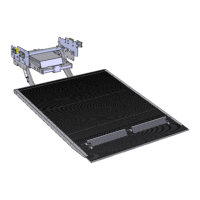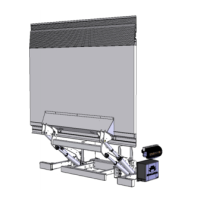
Do you have a question about the Dhollandia DH-V Series and is the answer not in the manual?
| Brand | Dhollandia |
|---|---|
| Model | DH-V Series |
| Category | Lifting Systems |
| Language | English |
Definitions for DANGER, WARNING, and CAUTION safety signs indicating hazard levels.
Definitions for NOTICE, SAFETY INSTRUCTIONS, and SAFETY ALERT SYMBOL signs.
Notification regarding the importance of using the most up-to-date manual version.
Important disclaimers regarding manufacturer liability for misuse, modifications, or non-OEM parts.
Warnings about risks of improper use, untrained operators, and unauthorized modifications.
Specific warnings against using the tail lift for purposes other than intended.
Details on identification labels, their information, and where they are affixed on the lift.
Overview of DHOLLANDIA tail lifts, their technology, and classification by drive mechanism.
Differentiates between external and internal lift platform operation modes.
Definitions for major lift components like columns, beams, cylinders, platform, and controls.
Definitions for specific components of the DH-VH* hydraulic external column lift.
Details on electrical safety valves, pressure relief, and flow compensating valves.
Explanation of optional mechanical platform locks and standard load capacity marking.
Information on double cable systems and load safety devices (LSD) for suspension failure.
Description of standard 2-hand external control boxes and tail lift on/off switches.
Information on fuses for electrical circuits against short-circuits and amperage peaks.
Details on toe-guard flaps, foot controls, and roll stops to prevent injuries.
Explanation of guard rails for preventing falls from the platform.
Methods to ensure the deployed platform is visible, including lights, flags, and cones.
Mandates adequate training, understanding of manual, and minimum age for operators.
Guidelines on PPE, hazard prevention, and safe practices during operation.
Steps for safe vehicle parking, brake application, engine shutdown, and use of stabilising legs.
Recommendations for ensuring platform visibility and adequate work area illumination.
Warning about staying clear of the platform's range of motion and pinch points.
Caution regarding the crushing zone between the lowering platform and the ground.
Hazard of crushing between the rising platform and the vehicle floor.
Risk of crushing by the closing platform against the vehicle body frame.
Specific warnings about hazards during platform closure and stowing in travel position.
Risks associated with lifting to heights, potential for falls, and required safety measures.
Hazard of persons being under the platform during lowering, and precautions to prevent this.
Risks of toes and feet being crushed or sheared between platform and vehicle floor/ground.
Hazards of crushing and shearing occurring at the vehicle roof level.
Warning about the overhead cross tube on certain lifts and potential hand crushing injuries.
Safe operating positions for main external and auxiliary controls.
Guidelines for maintaining safe footing and contact points when riding on the platform.
Specific safe positions for using handheld and internal controls.
Safe practices for foot controls and combined external/internal control systems.
Requirements for connecting auxiliary controls and safety switch dependencies.
Strict prohibition against bypassing or modifying any tail lift safety features.
Overview of three methods for handling column lifts at loading docks.
Step-by-step instructions for docking with the platform lowered below the vehicle floor.
Instructions for using the platform as a loading or bridge plate, including capacity limits.
Prohibitions and warnings regarding the use of forklifts and pallet jacks on the platform.
Procedures for safely stowing the platform in loading dock pockets or briefcases.
Key items to check before operating the tail lift for the first time daily.
Detailed visual checks of the lift frame, columns, runners, and mounting points.
Checks for the condition and operation of guard rails and toe-guard flaps.
Verification of auxiliary controls, platform locks, roll stops, and other features.
Performing movements to ensure smooth and quiet operation.
Emphasizes that maintenance must be done by authorized agents using OEM parts.
Procedures for taking a broken-down lift out of operation and securing it.
Guidance on using external devices for supporting the lift during certain operations.
Explanation of how rated capacity varies with load position and distance from the vehicle.
Essential warnings about the severe risks of overloading and improper loading practices.
Instructions and diagrams for proper load placement on the platform for safe operation.
Information on understanding and observing load chart decals on the lift.
Examples and warnings about recognizing and preventing hidden overload conditions.
Guidelines and warnings about not extending loads beyond the platform edges.
Description of how the platform moves during lifting and lowering, including platform orientation.
Emphasizes the necessity of properly securing loads on the platform to prevent shifting or falling.
Description and detailed steps for using the joystick-style external control box.
Description and detailed steps for using the Arctic control box for lift functions.
Operation of controls for stabilising legs and description of the flush mount control unit.
Instructions for ramp controls and description of the dual toggle-switch control box.
Critical safety warnings and precautions for using auxiliary controls from safe operator positions.
Details on LIFT/LOWER controls integrated into platform guard rails.
Descriptions and operations of various handheld, internal, and foot-operated auxiliary controls.
Information on external controls and systems with change-over switches.
How to use the cabin switch to turn the tail lift power on and off.
Operation of the main battery disconnect switch for power control.
Notice on managing power when both cabin and battery switches are present.
Step-by-step instructions for opening the platform from its travel position.
Detailed steps for safely loading and unloading goods using the tail lift.
Instructions for stowing the platform securely in its travel position.
Step-by-step guide for opening and preparing the internal platform.
Procedures for loading and unloading goods using the internal platform.
Instructions for stowing the internal platform securely for travel.
Critical safety warnings about lifting loads above the vehicle roof level.
Guidance on using stabilising legs and specific control box functions for removal lifts.
Step-by-step guide for opening the platform of the DH-VO.20.D4 removal lift.
Procedures for safely loading and unloading with the DH-VO.20.D4 removal lift.
Instructions for stowing the removal lift platform securely for travel.
Important information regarding the function of guard rails on removal executions.
Explanation of the function, capacity, and importance of stabilising legs.
Key recommendations and notices for proper use of hydraulic stabilising legs.
Essential points for the operator to observe when using stabilising legs.
Detailed procedures for operating 10T stabilising legs, including pin removal.
Critical warnings about load shifting and the necessity of securing cargo with roll stops.
Introduction to various roll stop models and their general operation.
Detailed instructions for operating automatic roll stops, including manual and automatic modes.
Detailed instructions for operating vertical roll stops, including manual and automatic modes.
Instructions for opening, raising, and closing rear or side retention ramps.
How to operate the electro-hydraulically operated hydraulic retention ramp.
Guidelines for affixing decals to the vehicle body and maintaining their legibility.
Emphasis on operator compliance with safety and instruction decals.
Note on how certain decals marked 'EXAMPLE' may vary based on lift capacity or control box type.
Explanation of common warning signs and the importance of heeding their messages.
Understanding signs that indicate required actions for safe operation.
Identification of signs that denote forbidden actions or conditions.
Definitions for commonly used signs related to procedures, status, and emergency actions.
Information on downloading the latest preventative maintenance and inspection checklists.
Instructions for downloading the latest version of the Maintenance and Repair Manual.
Recommendations for regular lubrication to ensure durability and reliability.












